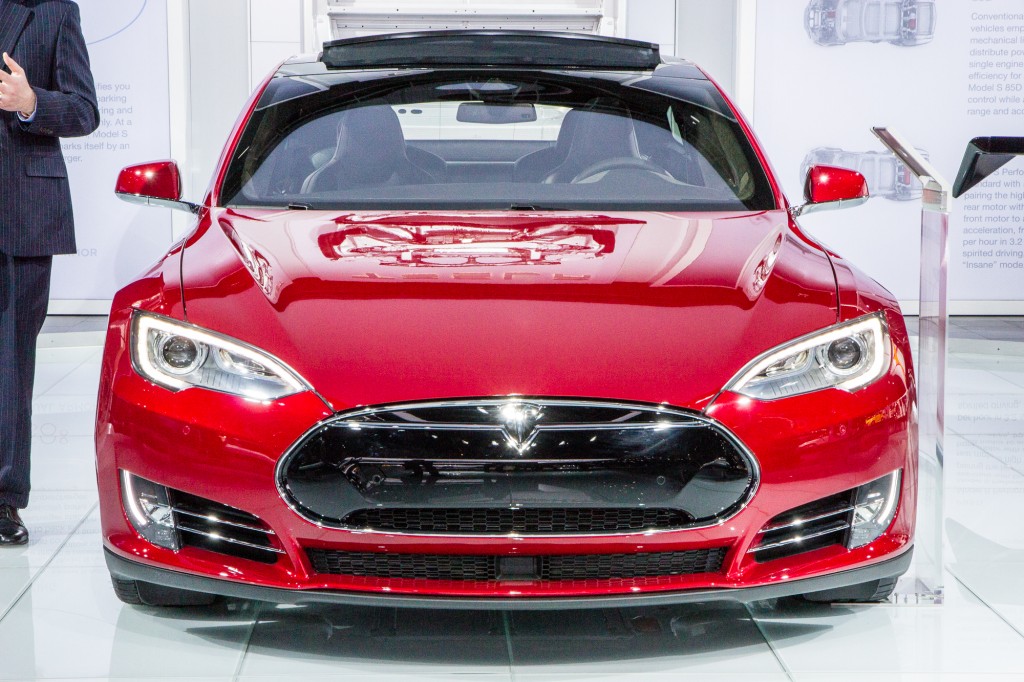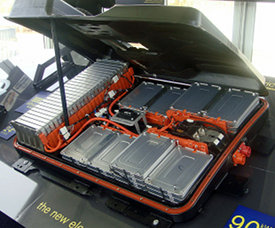![2014 Tesla Model S P85D, road test, Dec 2014 [photo: David Noland] 2014 Tesla Model S P85D, road test, Dec 2014 [photo: David Noland]](https://images.hgmsites.net/lrg/2014-tesla-model-s-p85d-road-test-dec-2014-photo-david-noland_100494837_l.jpg)
2014 Tesla Model S P85D, road test, Dec 2014 [photo: David Noland]
There’s been a lot of confusion recently about the official EPA-certified ranges of certain electric cars.
That all-important number goes on the window sticker, and is typically used for advertising and marketing purposes.
In November, Tesla Motors CEO Elon Musk announced, with great fanfare, that the new all-wheel-drive P85D version of the Tesla Model S electric car would actually be more efficient than the P85 model it replaced.
DON'T MISS: Tesla Model S P85D 'Insane' Mode: NSFW Video Shows How Fast It Really Is
Then the P85D hit the market late last year with an official EPA range of 242 miles—about 9 percent less than the P85’s 265 miles.
![2014 Tesla Model S P85D, road test, Dec 2014 [photo: David Noland] 2014 Tesla Model S P85D, road test, Dec 2014 [photo: David Noland]](https://images.hgmsites.net/lrg/2014-tesla-model-s-p85d-road-test-dec-2014-photo-david-noland_100494830_l.jpg)
2014 Tesla Model S P85D, road test, Dec 2014 [photo: David Noland]
In a similarly confounding case, the 2013 Nissan Leaf, which had an EPA range of 75 miles, improved to 84 miles for the 2014 model—even though the two cars were essentially the same.
What’s going on here?
It turns out the EPA range-rating procedure has a major grey area that can, and has, resulted in some buyer confusion.
Worse, that procedure actually led to one maker eliminating a battery-saving reduced-charge mode, at least theoretically posing the risk of shortening that car’s battery life.
SAE J-1634
Contrary to popular assumption, the car manufacturers themselves--not the EPA--perform the official range tests. (The EPA confirms results at its own lab for a minority of all new vehicles rated.)
ALSO SEE: 2014 Tesla Model S P85D: First Drive Of All-Electric AWD Performance Sedan
The Bible for both EPA and manufacturer testers is the Society of Automotive Engineers (SAE) document J-1634, which sets out a detailed protocol for range and efficiency testing of electric cars.

Tesla Model S P85D, 2015 Detroit Auto Show
The J-1634 procedure was originally issued in 1993, but the current document is a revision dated October 2012.
The range and efficiency tests—a single procedure called the Multi-Cycle Range and Energy Consumption Test, or MCT—specifies a detailed speed-vs-time driving script to mimic both city and highway driving.
There are complex equations to determine useable battery energy and climate-control energy consumption.
The document prescribes what kind of charger is to be used to recharge the battery. And so on.
It’s all extremely precise. There appears to be very little chance for uncertainty or confusion.
Except for one little item that's not nearly as precise: The level to which the battery must be charged at the start of the test.
Room for interpretation
There are actually two different scenarios for setting the battery charge level before the test.
In the case where the car automatically charges to the full 100-percent capacity whenever it’s plugged in—like the BMW i3 and the 2014 Nissan Leaf—the protocol calls for the battery to be charged to 100 percent. Pretty straightforward.
MORE: Tesla Model X Caught On Video In Acceleration, Cornering Tests
But for cars that have driver-adjustable charging levels—like the Tesla Model S, 2012-13 Nissan Leaf, and the 2015 Mercedes B Class electric—a different standard applies.

Tesla Model S P85D, 2015 Detroit Auto Show
Here’s the exact wording of J-1634:
“If multiple charging power (sic) levels are available, the vehicle shall be recharged at the power (sic) level recommended by the manufacturer. If not specified by the manufacturer, the recharging power (sic) level expected to be most widely utilized by end users shall be selected.”
Obviously, there’s a lot of room for interpretation in those two sentences.
(We note the incorrect use of the word “power” to describe the state of charge of the battery. Power is the rate at which energy is expended, not a specific level of energy. Taken literally, this paragraph seems to refer to the rate at which the battery is charged--but we were assured by an EPA spokesperson that it refers to the level of battery charge.)
![Tesla Model S P85D 'Insane' mode acceleration [frame capture from DragTimes video] Tesla Model S P85D 'Insane' mode acceleration [frame capture from DragTimes video]](https://images.hgmsites.net/lrg/tesla-model-s-p85d-insane-mode-acceleration-frame-capture-from-dragtimes-video_100498651_l.jpg)
Tesla Model S P85D 'Insane' mode acceleration [frame capture from DragTimes video]
Apples to apples?
So why should the availability of multiple levels of charging be a factor in setting how full the battery will be charged for the test?
For an apples-to-apples comparison—the whole purpose of the EPA range number, after all—you’d presumably want all electric-car ranges to reflect the same battery state of charge.
The obvious choice would be 100 percent of battery capacity. Clearly, any driver embarking on a trip long enough for maximum range to be an issue would choose to charge the battery fully.
(A certain reporter from The New York Times notwithstanding.)
![2014 Tesla Model S P85D, road test, Dec 2014 [photo: David Noland] 2014 Tesla Model S P85D, road test, Dec 2014 [photo: David Noland]](https://images.hgmsites.net/lrg/2014-tesla-model-s-p85d-road-test-dec-2014-photo-david-noland_100494837_l.jpg)
2014 Tesla Model S P85D, road test, Dec 2014 [photo: David Noland]
But in the EPA’s view, the apples being compared should not be the actual battery states of charge.
“The consistency we’re looking for is in what the manufacturer recommends,” says Linc Wehrly, a senior EPA engineer involved in the testing.
Recommends for what?
The printed owner’ manual that came with my Tesla 2013 Model S says, “By default, the Model S charges to the STANDARD charge level (90 percent SOC -ed)….To drive as far as possible, change the charge level to MAX RANGE. Although this setting charges the battery to full capacity, using it frequently reduces battery life.”
One could have a lively debate about whether this constitutes a recommendation. And if so, what is it recommending: 90 percent or 100 percent?

Tesla Model S P85D, 2015 Detroit Auto Show
The Tesla situation got even fuzzier when the company updated the car’s software to allow more driver adjustability.
The current owner’s manual makes nothing resembling a recommendation, saying only, “You may charge to any level from 50 percent to 100 percent based on your driving needs.”
'Most widely utilized'
J-1634 decrees that, if there is no manufacturer recommendation, the battery charge will be set at the “level expected to be most widely utilized by end users.”
Clearly, the 100-percent charge level is the most logical choice to be utilized by end users setting out on a long trip.
It also is most advantageous for the manufacturer, resulting in the highest possible range number.

2015 Nissan Leaf
Leaf puzzle
But consider the case of the Nissan Leaf.
The original Leaf, introduced in 2011, had an EPA range of 73 miles, tested under the original J-1634 protocol from 1993.
The 2013 model, tested under the 2012 revision, improved only slightly to 75 miles, despite better regenerative braking, better aerodynamics, and a weight reduction.
FURTHER DETAIL: 2013 Nissan Leaf: 75-Mile Range 'Anticipated' In New Test By EPA (Feb 2013)
Nissan said that, under the old rules, the 2013 Leaf would have had a much-improved range of 84 miles.
Then in 2014, the official EPA range increased to 84 miles—with virtually no changes to the car’s battery system, weight, or aerodynamics.
The problem involved the 2013 model’s “Long Life” charging mode, which limited battery SOC to 80 percent.
For shorter trips, a Leaf owner had the option of charging to 80 percent and putting a bit less stress on the battery.

Lithium-ion battery pack of 2011 Nissan Leaf, showing cells assembled into modules
Nissan says that the EPA required it to use the average of the ranges in the two charge modes: 65miles at 80-percent charge and 84 miles at 100-percent charge.
The EPA apparently decided that Nissan had “recommended” driving at an 80-percent charge, merely because that option was available.
According to a 2013 report, Nissan spokesman Brian Brockman stated that it was the EPA--not Nissan--that elected to average the ranges in the two charge modes.
An EPA spokesperson disputes that view, however: “At the time, Nissan said that they were not going to recommend a certain charging rate, so they agreed to average the range between the 100-percent and 80-percent charge rates.”
"We reported the [2013] range with 90 percent charge, as recommended by the EPA," said Brockman, in response to our further query.
"That changed when we removed Long Life Mode from the 2014 model."
2015 Nissan Leaf
Adds the EPA spokesperson, “We meet with all manufacturers prior to them performing official fuel economy label testing for EVs, and discuss the charge level they should use.”
Whoever was calling the shots, the 2013 Leaf paid a 10-percent penalty in rated range for the crime of allowing its drivers to select an 80-percent charge level.
Why not Tesla?
Ironically, it appears that Tesla, whose Model S also has multiple charging levels, has not been subjected to such range-reducing measures.
When Tesla’s P85D first appeared last month with an EPA window-sticker range of 242 miles, 9 percent less than its P85 predecessor, it appeared that Tesla had suffered the same fate as the 2013 Leaf.
That contrasted with Musk's claim that the all-wheel-drive P85D would actually be more efficient than the P85.
![2014 Tesla Model S P85D, road test, Dec 2014 [photo: David Noland] 2014 Tesla Model S P85D, road test, Dec 2014 [photo: David Noland]](https://images.hgmsites.net/lrg/2014-tesla-model-s-p85d-road-test-dec-2014-photo-david-noland_100494837_l.jpg)
2014 Tesla Model S P85D, road test, Dec 2014 [photo: David Noland]
But the EPA confirmed to me that Tesla has used 100-percent battery SOC for all its EPA range testing, including the most recent tests.
JB Straubel, Tesla's chief technology officer, has since clarified the Tesla range issue, confirming that the P85D does indeed have less range than the P85 under the same EPA protocol.
So why was Tesla allowed to use 100 percent battery SOC, while Nissan was not?
According to the EPA, “Tesla indicated to us that they recommended 100 percent charge.”
2014 Mercedes-Benz B-Class Electric Drive - First Drive, May 2014
Mercedes B-Class
As if there weren’t enough confusion already, consider the case of the Mercedes B Class electric.
The 2014 model has an EPA range of 87 miles, not counting an optional software “Range Package” that increases available battery energy and adds about 15 miles range.
No argument with the EPA here: If the Range Package is optional on the 2014 B-Class, it shouldn’t be counted for the base car.
But for 2015, Mercedes has made the Range Package a standard feature—in effect offering the driver two levels of charging.

2014 Mercedes-Benz B-Class Electric Drive - First Drive, May 2014
Following the logic, that would mean the range of the B Class would jump to 102 miles this year--or perhaps 94 miles, the average of 87 and 102.
But the listed EPA range number for the 2015 B-Class Electric Drive remains at the same 87 miles as for the previous year.
The real-world range of the B-Class, of course, is unchanged.
Mercedes-Benz did not respond to several requests for clarification of its interactions with the EPA.
Confusion vs clarity
It appears that the EPA charging protocol has achieved precisely the opposite of its intent: It has created confusion rather than clarity.
Perhaps worse, it has potentially shortened the battery life of 2014 and 2015 Nissan Leafs at least somewhat (although 2015 Leafs have a slightly altered battery chemistry that the company says is more resistant to very high temperatures than its earlier batteries).
The solution for the range puzzle would seem to be simple: The EPA should clarify the rule so that all range tests are done with the battery charged to 100 percent capacity.
It only seems fair.
_______________________________________________












